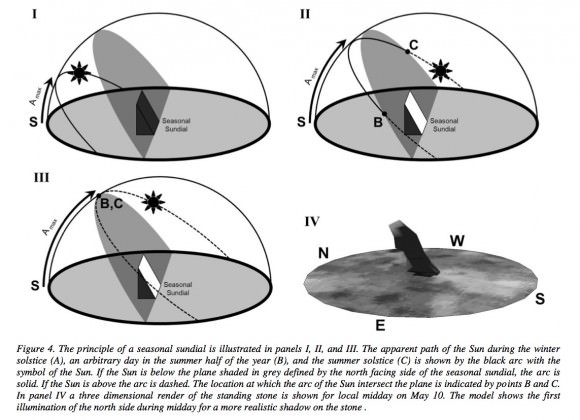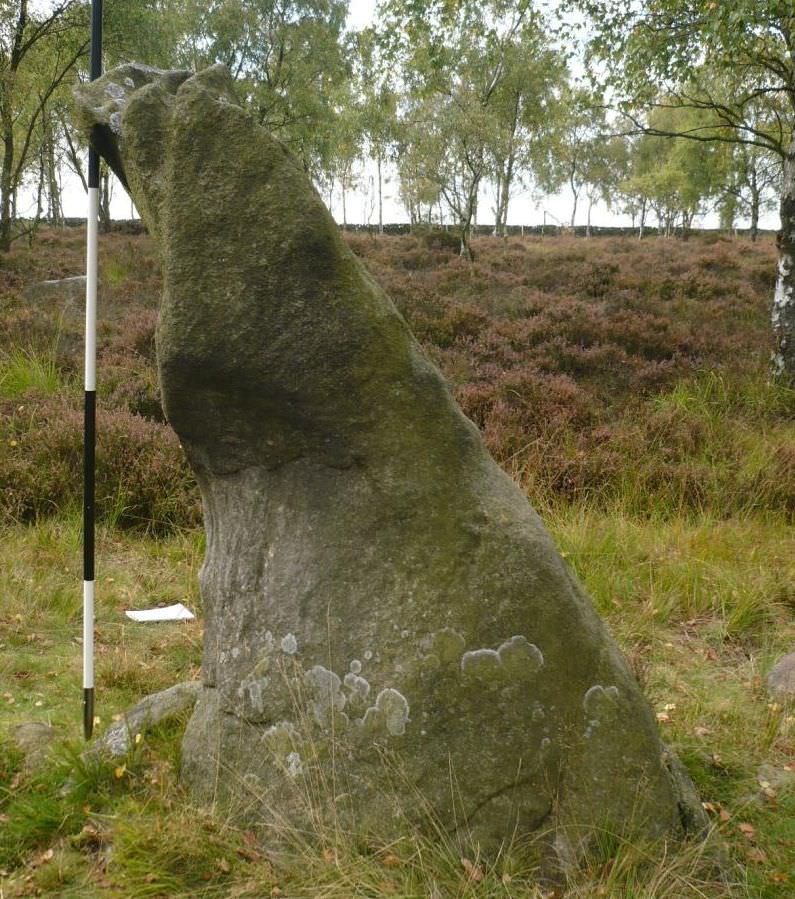[/caption]
Is this 2-meter-high slab of lichen-covered rock in a UK park an astronomical marker used by Neolithic people? Researchers from Nottingham Trent University are suggesting that may in fact be the case, based on the stone’s alignment, angle and proximity to other significant Stone and Bronze Age sites nearby.
The angular rock, known as the Gardom’s Edge Monolith, resides within the Peak District National Park in the central northern area of England. The research team has found that it’s aligned in such a way that its north side slopes at an angle equal to the maximum altitude of the Sun during the summer solstice.
Not thought to be so much a sundial as a seasonal dial, the shadows cast by the monolith seem to mark specific times of year… possibly denoting the “life cycle” of the Sun in the heavens.
Standing stones being rare in the region, It’s estimated that the monolith was set in place anywhere from 2,500 — 1,500 B.C. Evidence of packed stones and earth at the base also suggests human placement.
The team believes that the stone may have been a gathering point for ancient communities in the area.
“The stone would have been an ideal marker for a social arena for seasonal gatherings,” said Dr. Daniel Brown, lead author of the team’s paper. “It’s not a sundial in the sense that people would have used it to determine an exact time. We think that it was set in position to give a symbolic meaning to its location, a bit like the way that some religious buildings are aligned in a specific direction for symbolic reasons.”
Computer modeling of the stone and the Sun’s position throughout the year show that the stone’s slanted side would be in shadow during the winter, while during the summer it would be lit in the morning and afternoon. During midsummer, however, it would be illuminated all day.

More modeling and photographic work will be needed to confirm this hypothesis. If supported, it could lead to more archaeological study of the area.
Read the team’s full paper here, and read more on Sci-News.com.


Hi Jason,
Just had a quick look at this article. It seems to fall into line with the many Standing Stones in the Cornwall. Part of my research work covers this area.
Brian Sheen Roseland Observatory Cornwall.
Brian: have you heard any more of this research by Brown et al. from Nottingham Trent?
Hi Jason,
I had not head of this work before but will have to do some chasing now.
It is typical that some folk mix up proper science with Alien Invasion theories.
My work is recognised by the archaeologists in Cornwall and of course is still on going.
Personally I am always wary of claiming that odd rocks or mounds must be markers of one sort or another. However in the case of the Hurlers in Cornwall everything is belt and braces. An outline of the story is on my website http://www.roselandobservatory.com – a long way down the page though I fear.
I am about to write a popular article to be called “Under the Bronze Age sky” for publication in a Cornish magazine lets hope my write up of the historical aspects of the Transit of Venus does not get in the way!
Thank you for your interest in my comment.
Brian.
Now I’m feeling grumpy. Because such weekend topics will make me out as a grump:
No.
– As a rule, if a heading asks a question, the answer is “No”. =D
– But seriously, for the generic case: no archaeo-astronomical ideas has ever been validated to my knowledge. Archaeologists have found some actual observatories in India (which comes to mind) and elsewhere. But they were well described in literature I think, and are found by the accepted science in these cases.
A quick peek in arxiv shows the usual nuttery of a long list of archaeo-astronomical publications mixed with astronomy on the behalf of the authors. Dan Brown is a lecturer in astronomy. We have these showcases of endless futility (aka crackpots) here in Uppsala too, sad to say.
I could probably promise you that no archaeological work will ever be done on this untestable “hypothesis”, the likelihood is so minute that it will interest them.
– Specifically this is a futile and untestable exercise in pattern search. I’m sure everyone is familiar with how this is used by crackpots the world over, from homeopaths to astrologers.
I note that when people have made the effort to check these supposed alignments, they are never as good as published or sufficiently accurate to warrant the epithet.
And I also note that most stones are not put in place by humans but by geological forces. Around here you will find many odd placements due to ice age deposits. People used to blame the trolls. And now it can be blamed on ‘earlier’ humans. Ouch.
Now I’m feeling grumpy. Because such weekend topics will make me out as a grump:
No.
– As a rule, if a heading asks a question, the answer is “No”. =D
– But seriously, for the generic case: no archaeo-astronomical ideas has ever been validated to my knowledge. Archaeologists have found some actual observatories in India (which comes to mind) and elsewhere. But they were well described in literature I think, and are found by the accepted science in these cases.
A quick peek in arxiv shows the usual nuttery of a long list of archaeo-astronomical publications mixed with astronomy on the behalf of the authors. Dan Brown is a lecturer in astronomy. We have these showcases of endless futility (aka crackpots) here in Uppsala too, sad to say.
I could probably promise you that no archaeological work will ever be done on this untestable “hypothesis”, the likelihood is so minute that it will interest them.
– Specifically this is a futile and untestable exercise in pattern search. I’m sure everyone is familiar with how this is used by crackpots the world over, from homeopaths to astrologers.
I note that when people have made the effort to check these supposed alignments, they are never as good as published or sufficiently accurate to warrant the epithet.
And I also note that most stones are not put in place by humans but by geological forces. Around here you will find many odd placements due to ice age deposits. People used to blame the trolls. And now it can be blamed on ‘earlier’ humans. Ouch.
“Swedish is essentially English spoken backwards.”
– Dave Yarwood
*Runs and hides*
I heard an art historian say in a lecture in my youth that European stone liths in general — megaliths, common monoliths, and possibly Stonehenge, too — are basically grave-marker burial stones that may in some instances also be sundials. He probably didn’t consider or know that they more broadly might be time dials that are either timekeeping daily-use sundials or season-marking sundials.
Is there any evidence to indicate that is was moved or aligned into position? I mean, don’t we need some kind of evidence to indicate that it’s not… you know, a rock?
The earth at the base is said to be packed with stones, presumably keeping the monolith at an angle. They haven’t excavated (yet) so the actual size isn’t mentioned.
I read this on the first day of the month of April, so, I thought, what a wonderful April fool’s trick, and I laughed. We live in the golden era of astronomy.
rocks are sooooo cool.
It had me right up until it said ‘Standing stones being rare in the region’ – you can go just about anywhere in the UK and be within a few miles of some sort of standing stone or prehistoric construction – hell I live in Cheshire and its hardly renowned for prehistoric archeology, but in the fields that surround me I know of almost a dozen or more sites with some sort of erected stone.
According to the paper, single standing stones are “uncommon” in the immediate vicinity of the Gardom’s Edge monolith. So maybe not “region” as in all of northern England, but in the area where this particular stone is.
The whole of England is about the size of a single commercial canola or wheat field in western Canada (seriously). So when they say “immediate vicinity”, they mean within an hour’s easy walking distance.
Ahh, that particular stone was erected as a totem for the Sacred Sea-Lion, a mythical beast that one traveller told a small tribe about one day in order to con a free meal or two from them.
Heck, my invented explanation is as good as anyone’s. And it is a simpler one that bringing stars and planets and early astrophysicists into it.
Why do I get the Aprils fools day feeling?